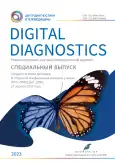Hydraulic circuit for pulse flow simulation in the tissue-mimicking aortic phantom
- Autores: Kodenko M.R.1,2, Guseva A.V.2
-
Afiliações:
- Moscow Center for Diagnostics and Telemedicine
- Bauman Moscow State Technical University
- Edição: Volume 4, Nº 1S (2023)
- Páginas: 35-36
- Seção: Conference proceedings
- URL: https://journals.rcsi.science/DD/article/view/147660
- DOI: https://doi.org/10.17816/DD430337
- ID: 147660
Citar
Texto integral
Resumo
BACKGROUND: Computed tomographic angiography (CTA) is the “gold standard” in the diagnosis of most vascular pathologies. The optimal method to improve this technique is the use of anthropomorphic tissue-mimicking phantoms, since CTA is accompanied by radiation exposure and the risk of allergic reactions when using contrast agents. In addition to compliance with the X-ray properties of the vessel, the pulsations occurring in the aorta in vivo must be simulated. A review of existing solutions demonstrates a small number of national developments in this area at a relatively high cost of foreign analogues. Moreover, the lack of reproducible methodology for creating pulse flow simulation devices using available and inexpensive materials is worth noting.
AIM: To develop a hydraulic circuit to simulate pulse blood flow in a tissue-mimicking aortic phantom.
METHODS: A literature analysis of existing pulse flow simulation devices and tissue-mimicking phantoms of the abdominal aorta was conducted. The medical and technical requirements for the designed device were formulated. The control circuit was developed, the circuit element base was determined, and the hydraulic circuit prototype was assembled. Based on a literature review, a material suitable for reproducing the biomechanical characteristics of arterial tissue was selected. A simplified phantom of the abdominal aortic segment was made. The device model included a simplified abdominal aortic phantom, a control system, a pump, a pressure sensor, a flow meter, and a flow regulator. Initial testing of the developed circuit in the basic signal mode and in the real flow profile simulation mode was performed. The basic signals were periodic rectangular signals reproduced at different frequencies, simulating normal, rapid, and slow heart rate. Using pulse-width modulation, a profile of the pressure pulse wave was obtained.
RESULTS: The developed hydraulic circuit allowed successful reproduction of pressure and flow velocity profiles in a tissue-mimicking aortic phantom. Further development of the project will involve fabrication and validation of the circuit (using anthropomorphic versions of the phantom) and simulation of the angiographic study.
CONCLUSIONS: The results may be useful for the improvement of CTA techniques and the development of angiosurgical training stands.
Texto integral
##article.viewOnOriginalSite##Sobre autores
Maria Kodenko
Moscow Center for Diagnostics and Telemedicine; Bauman Moscow State Technical University
Autor responsável pela correspondência
Email: m.r.kodenko@yandex.ru
ORCID ID: 0000-0002-0166-3768
Código SPIN: 5789-0319
Rússia, Moscow; Moscow
Anastasia Guseva
Bauman Moscow State Technical University
Email: anastas_g01@mail.ru
ORCID ID: 0009-0006-1787-4726
Rússia, Moscow
Bibliografia
- Rengier F, Geisbüsch P, Vosshenrich R, et al. State-of-the-art aortic imaging: part I — fundamentals and perspectives of CT and MRI. Vasa. 2013;42(6):395–412. doi: 10.1024/0301-1526/a000309
- Doppler Flow Pump [Internet]. Hospimedica Expo [cited 2023 Jun 03]. Available from: https://mobile.hospimedica.com/expo/product/8996/doppler-flow-pump-model-model-769.
- Kwon J, Ock JH, Kim N. Mimicking the mechanical properties of aortic tissue with pattern-embedded 3D printing for a realistic phantom. Materials. 2020;13(21):5042.
Arquivos suplementares









